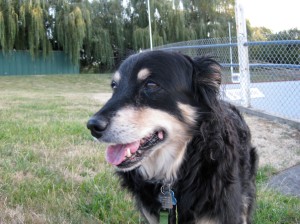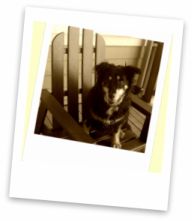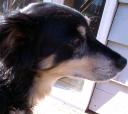 Sophie died on December 1st. It was the right day. A day earlier, I would have had hope for recovery. A day later, I would have felt guilty for putting her through extra pain.
Sophie died on December 1st. It was the right day. A day earlier, I would have had hope for recovery. A day later, I would have felt guilty for putting her through extra pain.
The last month was glorious. We increased the piroxicam, and the uplift was immediate. B. even started taking her back to the dog park. Sophie caught toys and played hide-and-seek and performed tricks we hadn’t seen in a year.
We all went to a relatives’ house for Thanksgiving, and Sophie had two accidents. She never, never had accidents but we assumed it was from all the excitement. She was sick through the weekend, but we dismissed it as something she ate at Thanksgiving.
But by Tuesday, we knew things were serious and weren’t surprised when the vet said there was nothing left to do.
As devastated as we feel, we are mindful of the extra time we had. Sophie should have died of chondrasarcoma. But thanks to diligent veterinarians, one debulking surgery, and 21 radiation sessions, she was thriving. She never had another symptom and didn’t even develop cataracts from the radiation.
Her downfall was, instead, transitional cell carcinoma (TCC) that was growing in her urethra. Either the tumor or a bladder stone blocked her urethra so that she couldn’t urinate, resulting in too much potassium in her system which led to heart failure.
If you happened to catch this blog because you were looking for information on canine chondrosarcoma, welcome. It’s full of good news– our experience with debulking and radiation was easy, routine, and worth every penny. I hope you can benefit from our experience.
 Cancer is no longer a word we use daily and it’s hard to remember how scary it was when we started this journey. If you are looking for current information on canine nasal chondrosarcoma, there is an abundance of information online.
Cancer is no longer a word we use daily and it’s hard to remember how scary it was when we started this journey. If you are looking for current information on canine nasal chondrosarcoma, there is an abundance of information online.
 Sophie went back to the vet this week. She had starting sneezing those abnormal sneezes again. They’re like potato chips– you can’t have just one; Sophie can easily sneeze 12 times in a row. I get tired just watching.
Sophie went back to the vet this week. She had starting sneezing those abnormal sneezes again. They’re like potato chips– you can’t have just one; Sophie can easily sneeze 12 times in a row. I get tired just watching. An unexpected side effect started this week. In the middle of the night, Sophie’s jaw started to tremble uncontrollably and make her teeth click violently together. This little tremor would continue for a minute, stop for a while and then start again. We were all scared and exhausted by sunrise.
An unexpected side effect started this week. In the middle of the night, Sophie’s jaw started to tremble uncontrollably and make her teeth click violently together. This little tremor would continue for a minute, stop for a while and then start again. We were all scared and exhausted by sunrise.



